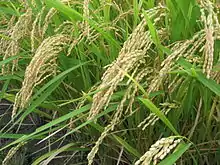Japonica rice
Japonica rice (O. sativa subsp. japonica), sometimes called sinica rice, is one of the two major domestic varieties of Asian rice. Japonica rice is extensively cultivated and consumed in China, Japan, and Korea, whereas in most other regions indica rice is the dominant type of rice. Japonica rice originated from Central China, where it was first domesticated along the Yangtze River basin approximately 9,500 to 6,000 years ago.[1][2][3]
.jpg.webp)

Characteristics
Japonica rice grains are rounder, thicker, and harder, compared to longer, thinner, and fluffier indica rice grains. Japonica rice is also stickier due to the higher content of amylopectin, whereas indica rice starch consists of less amylopectin and more amylose.[4] Japonica rice plants are shorter than indica rice plants.
Classification
Japonica rice can be classified into three subgroups, 'temperate japonica',[5] 'tropical japonica' (also known as 'javanica', Oryza sativa subsp. javanica),[6][7] and 'aromatic'.[8] Temperate japonica is cultivated in East Asia (China, Japan, Korea, Vietnam, and Taiwan), while tropical japonica is in Indonesia, Madagascar, and also the Americas where it was brought to with slave trade.[9]
Cultural significance
In Korea, rice is called by non-interchangeable names. Ssal (쌀), byeo (벼), or mo (모) are the names used depending on the growth stages of rice. Ssal refers to peeled grains of rice and rice in a generic sense. Rice plants are called byeo, while rice seedlings grown to be transplanted to paddies are called mo. Transplantation of mo is called monaegi (모내기), and rice fields are called non (논). Since other fields are called bat (밭), the generic term for "agricultural field" in Korean is nonbat, which literally means "rice field and other fields". There is even a Korean-coined Chinese character for rice field: 畓 (pronounced dap(답) in Korean). Since the paddy fields for rice are irrigated lands, the character is a compound ideograph made of 水 ("water", pronounced su (수) in Korean) and 田 ("field", pronounced jeon (전) in Korean). The Sino-Korean term jeondap is used as a synonym of nonbat. Cooked rice is called bap (밥, regular "cooked rice"), juk (죽, "congee"), nurungji (누룽지, "scorched rice"), and so on according to cooking methods.
See also
References
- M. A., Anthropology; B. Ed., Illinois State University; Twitter, Twitter. "The Origins and History of Rice in China, India/Pakistan and Africa". ThoughtCo. Retrieved 2020-08-02.
- "Rice's origins point to China, genome researchers conclude | The Source | Washington University in St. Louis". The Source. 2011-05-02. Retrieved 2020-08-02.
- Gross, Briana L.; Zhao, Zhijun (2014-04-29). "Archaeological and genetic insights into the origins of domesticated rice". Proceedings of the National Academy of Sciences. 111 (17): 6190–6197. doi:10.1073/pnas.1308942110. ISSN 0027-8424. PMID 24753573.
- Kim, Jin-young (4 November 2016). "Endless Variations on Rice". Koreana. Korea Foundation. Retrieved 27 December 2016.
- "Oryza sativa temperate japonica subgroup". www.uniprot.org.
- "javanica rice". International Rice Research Institute. Retrieved 27 December 2016.
- "Oryza sativa tropical japonica subgroup". www.uniprot.org.
- "Oryza sativa aromatic subgroup". www.uniprot.org.
- 松尾 弌之. (2009).“「アメリカ50州」の秘密 “ レッカ社 ISBN 4569673023
.jpg.webp)



